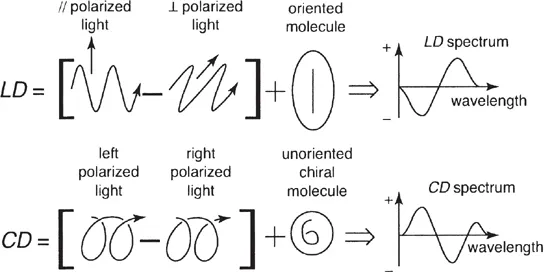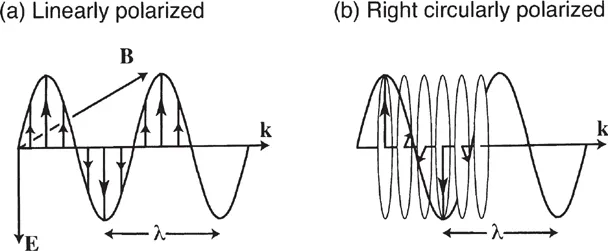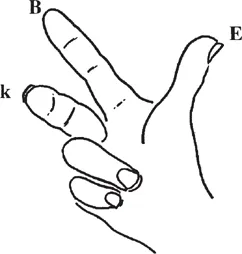![]()
1 Linear and circular dichroism spectroscopy: basic principles
1.1 Introduction
1.2 Electromagnetic radiation and spectroscopy
1.3 Normal absorption spectroscopy
1.4 Linear dichroism
1.5 Circular dichroism
Measurement of linear or circular dichroism involves shining two polarizations of respectively linearly or circularly polarized light onto a sample. Any resultant difference in absorption of the light polarizations gives information about the environment and the structures of the molecules contained in the sample. This chapter contains an introduction to both linear and circular dichroism.
1.1 Introduction
The aim of this book is to show how linear dichroism and circular dichroism spectroscopies can be used to provide information about molecular structure and about interactions between molecules.
The somewhat odd word ‘dichroism’ is derived from the Greek διχρωμα meaning ‘two colours’2 since for some samples two colours are seen when they are viewed from two different directions. Dichroism was first observed for crystals: when light that has passed through a polarizer shines on a dichroic crystal, the colour you will see depends on the orientation of the crystal relative to the polarizer.
Amethyst is an example of a dichroic crystal. It is a form of crystalline quartz with transition metal ‘impurities’ which shows distinct dichroism, e.g., bluish violet and reddish violet for the ordinary and extraordinary rays, respectively.1
Figure 1.1 Schematic illustration of LD and CD.
Chiral is derived from a Greek word ξειρ meaning hand (hence the alternate term ‘handedness’). Two molecules that are non-identical mirror images of each other are often referred to as enantiomers.
Superposed technically means: to place one geometric figure over another so that all like parts coincide. The more commonly used ‘superimposed’ does not require the coincidence of all like parts.
Although polarized light has not yet been defined in this book, it is still appropriate to begin with the definitions of linear and circular dichroism (Figure 1.1). Linear dichroism (LD) is the difference in absorption, A, of light linearly polarized parallel (//) and perpendicular (⊥) to an orientation axis:
LD is used with systems that are either intrinsically oriented or are oriented during the experiment. Circular dichroism (CD) is the difference in absorption of left and right circularly polarized light:
CD is particularly useful for studying solutions of chiral molecules, by which we mean ones that cannot be superposed on their mirror images.2
The justification for our interest in LD and CD is that both oriented systems and chiral systems are intrinsic features of the world in which we live. Oriented molecular systems are key components of biological cells as well as leading to macroscopic effects such as crystals, liquid crystals, membranes, and muscles; and all biological systems and many non-living ones are chiral. Sometimes the oriented system is itself built up of chiral molecules and the whole system may exhibit a macroscopic handedness.
This book is designed like a ramp with the text getting gradually more advanced: one starts to read at the beginning and continues until sufficient information has been covered for the purpose at hand. Chapter 1 contains all that is necessary to understand the basic concepts of LD and CD spectroscopies; Chapter 2 continues with what is required to enable the techniques to be implemented in the laboratory. Subsequent chapters are presented with increasingly detailed levels of interpretation and analysis of data. The emphasis of Chapters 3-6 is on the analysis of experimental data, and in the final chapters the theoretical foundations are laid. A selection of general references may be found in references 3-16.
1.2 Electromagnetic radiation and spectroscopy
Electromagnetic radiation
Electromagnetic radiation, as its name implies, has an electric field, E, and a magnetic field, B; these oscillate at right-angles to one another and to the propagation direction. It may be described by a transverse wave whose polarization is defined by the direction of its electric field (Figure 1.2). Electromagnetic radiation also has particle character. It is impossible to really understand wave-particle duality, we just have to accept the dual character of light. If we do an experiment that would probe wave-like behaviour, it is apparent that light has it, and if we look for particle character we find that too. Thus we refer to the wavelength, λ, (or frequency, ν) of radiation, but acknowledge that if a molecule absorbs radiation energy it is as discrete units or particles called photons.
Figure 1.2 (a) Linearly and (b) circularly polarized electromagnetic radiation. Arrows denote direction of E. The hand on the right indicates the relative orientations of E, B, and k with the so-called ‘right-hand rule’. E, B and k (the direction of propagation of the radiation) are related by equations derived by James Clerk Maxwell in 1864. B = (1/c) k × E with c the velocity of light and × denoting the vector cross product (see §11.1 for a brief discussion of vector products).
Vectors, denoted throughout by bold letters, are a convenient way of summarizing information about physical phenomena that have magnitude (the vector’s length) and a direction in space (indicated by where the arrow points). See §11.1.
Electromagnetic radiation is referred to as light if the energy range of interest is near the visible or easily accessible ultraviolet (UV) wavelength range (~ 170-800 nm).
Two types of polarized light are mentioned above: linear and circular. In a linearly polarized light beam all photons have their electric field, E, oscillating in the same plane, whereas in a circularly polarized light beam the electric field vector retains constant magnitude in time but traces out a helix about the propagation direction. Following the optics convention, we take the end of the electric field vector of right circularly polarized light to form a right-handed helix in space at any instant of time. At each point in space or time, the magnetic field, B, is perpendicular to the electric field such that k, E, and B form a right-handed system as illustrated in Figure 1.2.
If we view right circularly polarized light sitting at a fixed point in space looking towards the light source, down the direction of propagation k, then the electric field vector traces out a clockwise circle.
While linearly polarized (plane-polarized) light is characterized by the electric field vector oscillating in a plane, circularly polarized light is a form of polarization in which the field vector describes a cork-screw motion, completing one turn of a helix after having travelled a distance equal to the wavelength of light. The two forms of light polarizations obviously have quite different ‘textural’ features, one looking symmetric, the other looking asymmetric, like a screw. This textural difference illustrates the basis for quite different applications of the two forms of dichroism in the study of molecular structure: linear dichroism using linearly polarized light probes macroscopically oriented molecules, whereas circu...






